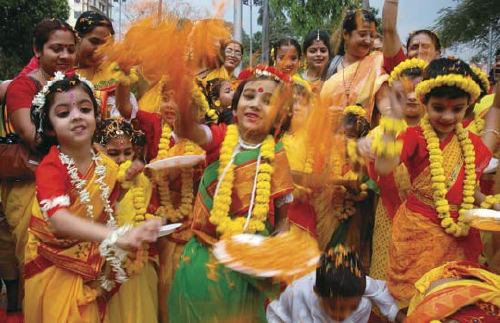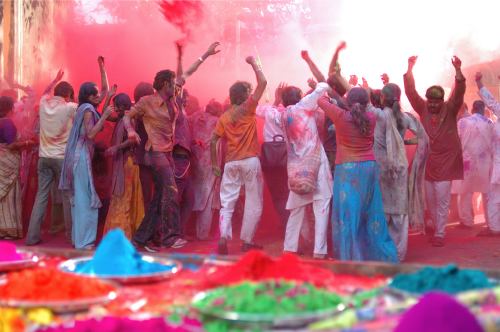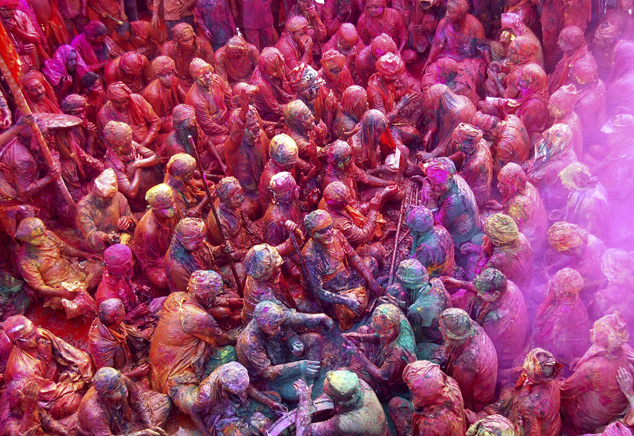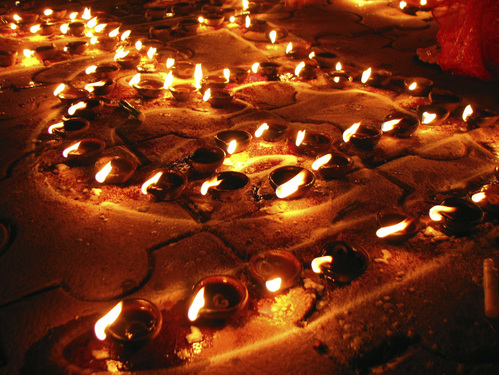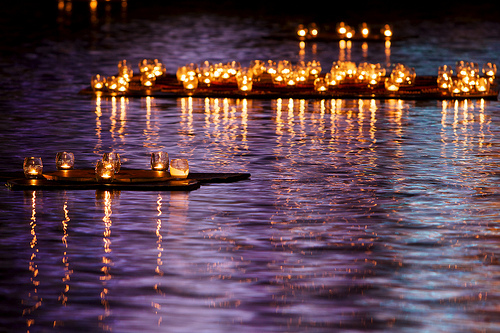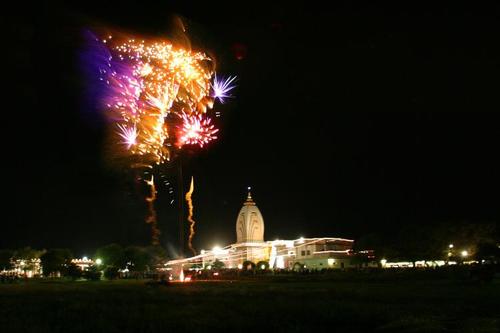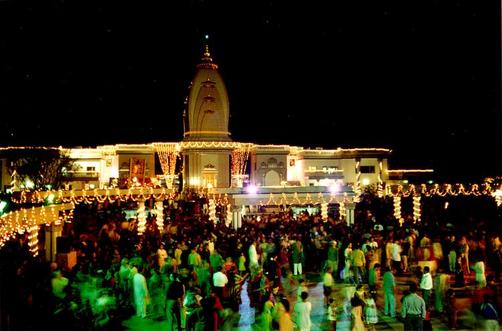| A Brief Introduction to Hinduism |
Hindu Holidays
Holi
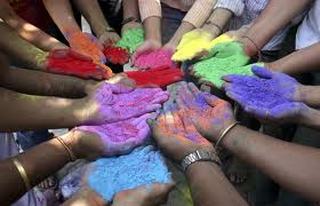
Holi is a festival in early March to celebrate the departure of winter and the arrival of spring. It's also a time to loosen social norms, allowing the normally separate castes to mingle. During Holi, normally unacceptable practices are tolerated joyfully, as Subhamoy Das describes: "Squirting colored water on passers-by, dunking friends in mud pools amidst teasing and laughter, getting intoxicated on bhaang and reveling with companions is perfectly acceptable. In fact, on the days of Holi, you can get away with almost anything by saying, 'Don't mind, it's Holi!' (Hindi = Bura na mano, Holi hai.)"
The story of Holi regards King Hiranyakashipu, who required his son, Prahlad, to worship him. Prahlad refused, instead becoming a follower of Vishnu. The king ordered his sister, Holika, to take the boy and burn him alive. Holika agreed because she possessed the ability to walk through fire without getting burned. But when she walked into the fire, she realized that her powers only worked when she entered alone, and she was burned alive. Prahlad survived, however, by chanting the names of Vishnu. As Holika burned, she pleaded with Prahlad to remember her, which he did by establishing the day of Holi. The gods are said to celebrate Holi as well. In fact, some sects say that the use of the colored powders on Holi was established by Lord Krishna. He once applied such colors to Radha's face, because she had darker complexion and he was jealous of her.
Holi usually lasts anywhere from two to sixteen days, with three being the most common.
The story of Holi regards King Hiranyakashipu, who required his son, Prahlad, to worship him. Prahlad refused, instead becoming a follower of Vishnu. The king ordered his sister, Holika, to take the boy and burn him alive. Holika agreed because she possessed the ability to walk through fire without getting burned. But when she walked into the fire, she realized that her powers only worked when she entered alone, and she was burned alive. Prahlad survived, however, by chanting the names of Vishnu. As Holika burned, she pleaded with Prahlad to remember her, which he did by establishing the day of Holi. The gods are said to celebrate Holi as well. In fact, some sects say that the use of the colored powders on Holi was established by Lord Krishna. He once applied such colors to Radha's face, because she had darker complexion and he was jealous of her.
Holi usually lasts anywhere from two to sixteen days, with three being the most common.
- Purnima: On the first day, family members take the colored powders for which Holi is famous and sprinkle them all over each other. The eldest male begins, and each member follows in order of age.
- Puno: During this day, Holika is burned in effigy. Huge bonfires are often lit in the evenings, and mothers will walk around the fires with their children to receive the blessings of the fire god, Agni.
- Parva: The most beloved day of Holi, Parva is the day when people gather together in large groups and throw colored powders at each other in a visually striking demonstration of the new life of spring. People even smear color on the faces of the various deities as a sign of fun and devotion.
Diwali
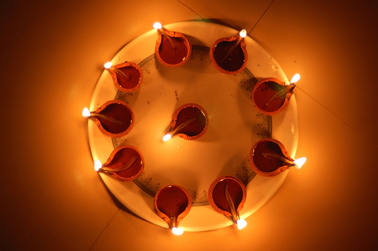
Diwali is one of the most known and most celebrated Hindu holidays. Its full name, Deepawali, means "Festival of Lights." A good way to conceptualize the role of the holiday in India is that Diwali is like Christmas to Christians. Because no universal Hindu calendar exists, the dates of this holiday vary, falling sometime between October and November.
During Diwali, people light small oil candles and place them around the home. Some set small candles afloat in nearby lakes. (Some even light neon lights instead, if they are rich and want to "show off," and in some places, fireworks are popular.) Depending on one's sect, these symbolize different deities, but the overall theme is that it represents the triumph of good over evil through the metaphor of light removing darkness. Though there are other practices, the two most common reasons for Diwali are to honor Lord Rama and for followers of Lakshmi to celebrate the goddess. Each Diwali festival takes place over five days.
During Diwali, people light small oil candles and place them around the home. Some set small candles afloat in nearby lakes. (Some even light neon lights instead, if they are rich and want to "show off," and in some places, fireworks are popular.) Depending on one's sect, these symbolize different deities, but the overall theme is that it represents the triumph of good over evil through the metaphor of light removing darkness. Though there are other practices, the two most common reasons for Diwali are to honor Lord Rama and for followers of Lakshmi to celebrate the goddess. Each Diwali festival takes place over five days.
- Dhanteras: During this day, houses and businesses are heavily redecorated to emphasize color.To recognize the arrival of a household's chosen deity, Hindus use rice powder and vermillion to draw footprints all over the floor. Hymns are sung in the evening to a Hindu's particular god, and the oil lights are lit and kept alight all night.
- Nakra-Chaturdashi: This day is dedicated to one of Lord Krishna's victories. On this day, he was said to have freed 16,000 harem-members and slaves from a demon king in Nepal. To prove his victory, he returned with the blood of the king smeared on his head. Due to this, Hindus traditionally take baths before dawn on this day, to symbolize cleanliness. Later in the day, some break melons on their front porches, re-enacting Krishna's victory. For non-Vaishnavists, the practices remain similarly focused on baths and cleanliness. Candles are still very important, remaining lit through this night as well.
- Lakshmi Puja: This day is dedicated to the goddess Lakshmi, who wanders around and bestows wealth on people. Coupled with this, Lord Shiva is said to have promised wealth to those who gamble on this night of Diwali; thus, gambling, particularly card games such as Rummy, is a common evening pastime. The candles, as always, remain lit.
- Varshapratipada: On this day, people decorate with flowers and scented oils to celebrate Lord Krishna. The statues of deities are given milk baths to honor them. For married couples, wives paint their husbands' foreheads with their castes' Tilak, and husbands return the favor with a large gift. Newly-married couples are invited to feasts to celebrate their love. Candles still remain lit.
- Bhayya-Duj: This final day of Diwali is a time to reflect on the love between sisters and brothers. It is said that on this day Yamraj, the god of death, visited his sister, Yami. She decorated him with a Tilak. Then they shared food and drink, and gave each other special hand-made gifts.
Sources:
http://hinduism.about.com/od/holifestivalofcolors/a/holybasics.htm
http://www.religionfacts.com/hinduism/holidays/holi.htm
http://www.princetonol.com/groups/iad/links/holi.html
http://totallycoolpix.com/2011/03/holi-day-aka-festival-of-colours/
http://www.sscnet.ucla.edu/southasia/Culture/Festivals/Diwali.html
http://www3.kumc.edu/diversity/ethnic_relig/diwali.html
http://members.tripod.com/~jennifer_polan/diwali.html
http://www.religionfacts.com/hinduism/holidays/diwali.htm
http://www.radhamadhavdham.org/events-celebrations
http://www.tonyblairfaithfoundation.org/newsroom/entry/a-diwali-reflection-by-professor-anantanand-rambachan/
http://freeimagefinder.com/tag/diwali.html
http://hinduism.about.com/od/holifestivalofcolors/a/holybasics.htm
http://www.religionfacts.com/hinduism/holidays/holi.htm
http://www.princetonol.com/groups/iad/links/holi.html
http://totallycoolpix.com/2011/03/holi-day-aka-festival-of-colours/
http://www.sscnet.ucla.edu/southasia/Culture/Festivals/Diwali.html
http://www3.kumc.edu/diversity/ethnic_relig/diwali.html
http://members.tripod.com/~jennifer_polan/diwali.html
http://www.religionfacts.com/hinduism/holidays/diwali.htm
http://www.radhamadhavdham.org/events-celebrations
http://www.tonyblairfaithfoundation.org/newsroom/entry/a-diwali-reflection-by-professor-anantanand-rambachan/
http://freeimagefinder.com/tag/diwali.html
